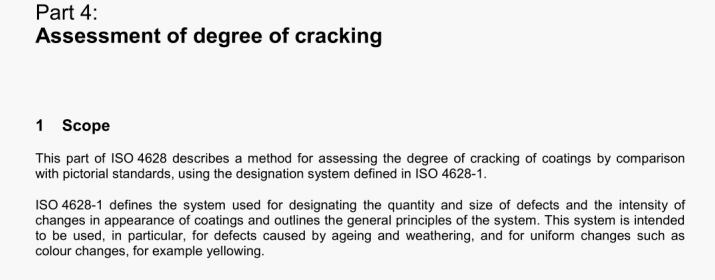Assessment of degree of cracking

BS EN ISO 4628-4:2003 pdf free.Paints and varnishes – Evaluation of degradation of coatings一Designation of quantity and size of defects, and of intensity of uniform changes in appearance- Part 4: Assessment of degree of cracking.
This part of ISO 4628 describes a method for assessing the degree of cracking of coatings by comparison with pictorial standards, using the designation system defined in ISO 4628-1.ISO 4628-1 defines the system used for designating the quantity and size of defects and the intensity of changes in appearance of coatings and outlines the general principles of the system. This system is intended to be used, in particular, for defects caused by ageing and weathering, and for uniform changes such as colour changes, for example yellowing.
2 Normative references
The following referenced documents are indispensable for the application of this document. For dated references, only the edition cited applies. For undated references, the latest edition of the referenced document (including any amendments) applies.
ISO 4628-1. Paints and varnishes — Evaluation of degradation of coatings — Designation of quantity and size of defects, and of intensity of uniform changes in appearance — Part 1: General introduction and designation system
3 Terms and definitions
For the purposes of this document, the following terms and definitions apply.
degree of cracking
rating characterizing cracks in a coating in terms of quantity, size and depth
4 Assessment
Assess the quantity of cracking by reference to Table 1 and using as an example Figure 1 or 2, depending on the type of cracking.
NOTE Figure 1 shows cracking without preferential direction and Figure 2 shows cracking in one preferential direction, which occurs with substrates such as wood (anisotropic substrates). Other forms of cracking occur, but the principles of assessing the quantity remain the same.
Where the test area exhibits cracks of various sizes, quote as the size rating that of the largest cracks which are numerous enough to be typical of the test area.
If possible, indicate the depth of cracking by reference to the level in the coating system to which the cracks penetrate. A distinction is made between three main types of failure by cracking:
a) surface cracks which do not fully penetrate the top coat (i.e. checking);
b) cracks which penetrate the top coat, the underlying coat(s) being substantially unaffected;
c) cracks which penetrate the whole coating system.
Carry out the assessment under good illumination.
5 Expression of results
The numerical ratings for the quantity and, if specified, size of the cracks, together with the depth of cracking (a, b or c), shall be indicated as given in the following example:
cracking; degree of cracking 2(S3)b1),
together with the approximate dimensions of the area concerned, or its proportion of the total area, expressed as a percentage.
If necessary, the assessment may be amplified in words, for example “cracking in one preferential direction” and by using the descriptions given in Annex A.
6 Test report
The test report shall contain at least the following information:
a) all details necessary to identify the coating examined;
b) a reference to this part of ISO 4628 (ISO 4628-4:2003);
c) the type of surface examined, its size and, if appropriate, its location;
d) the result of the assessment in accordance with Clause 5;
e) an indication of the ilumination under which the assessment was carried out;
f) any unusual features (anomalies) observed during the assessment;
g) the date of the examination.BS EN ISO 4628-4 pdf free download.Assessment of degree of cracking